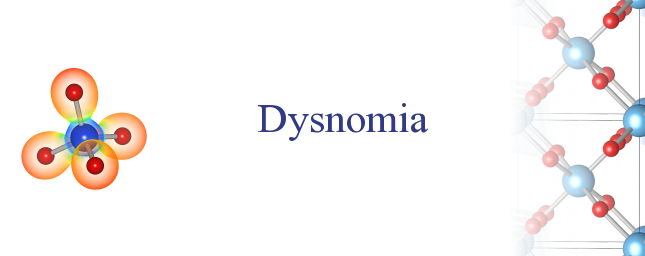Introduction
Dysnomiaは最大エントロピー法(Maximum Entropy Method: MEM)を用いて、結晶構造中の電子・核密度分布をX線/中性子回折データから解析するソフトウェアです。DysnomiaはPRIMAの後継ソフトウェアで、実行方法や入力ファイル形式はPRIMAとの後方互換性を維持しています。
ダウンロードファイルを任意の場所に解凍するだけで、特別な設定なしに実行できますが、RIETANの統合支援環境を使用する場合は、解凍したファイル一式をRIETAN_VENUSフォルダーにコピーしてください。
License agreement
Dysnomia LICENSE
Version 1
Copyright (C) 2011-2021, Koichi Momma and Fujio Izumi
Version 1
Copyright (C) 2011-2021, Koichi Momma and Fujio Izumi
Dysnomia is distributed free of charge but currently copyrighted with its source code not open to the public because we wish to control its development and future by ourselves. Permission to use this software is hereby granted under the following conditions:
- Whenever original results acquired with Dysnomia are published in journals, proceedings,
and review articles, the program name "Dysnomia" should explicitly be stated, and the
following article must be quoted:
Only giving credit to Dysnomia is suffice in the cases of abstracts, facility reports, and so
forth with limited spaces, for example, as follows:
Electron-density distributions in CaTiO3 were determined by MPF from the X-ray diffraction data with Dysnomia.
- Dysnomia is provided "as is" without any expressed or implied warranty. We do not provide any technical support for free.
- You should not redistribute any copy of the distributed files unless you have a written permission from us.
If you find a problem or a bug on use of Dysnomia, please let us know and help us improve it.
ダウンロード
 Windows
Windows- Dysnomia.zip (ver. 1.0, built on Dec. 8 2018, 14.2MB)
Windows XP以降で動作する32 bitと64 bitバージョンの両方を含んでいます。
 macOS
macOS- Dysnomia.dmg (ver. 1.0, built on Dec. 8 2018, 13.8MB)
OS X 10.9以降で動作。
 Linux
Linux- Dysnomia-i686.tar.bz2 (ver. 1.0, built on Dec. 8 2018, 4.53MB)
- Dysnomia-x86_64.tar.bz2 (ver. 1.0, built on Dec. 8 2018, 11.1MB)
Examples
- Dysnomia_Examples.zip (3.87MB, Uploaded on Jul. 14 2015)
Manual
- Dysnomia_Manual.pdf (122KB, uploaded on Dec. 2 2014)
参考文献
- K. Momma, T. Ikeda, A. A. Belik and F. Izumi: Dysnomia, a computer program for maximum-entropy method (MEM) analysis and its performance in the MEM-based pattern fitting. Powder Diffr., 28, 184-193, (2013).
- K. Momma and F. Izumi: Evaluation of algorithms and weighting methods for MEM analysis from powder diffraction data, Z. Kristallogr. Proc., 1, 195-200 (2011).
- F. Izumi & K. Momma: Three-dimensional visualization of electron- and nuclear-density distributions in inorganic materials by MEM-based technology. IOP Conf. Ser.: Mater. Sci. Eng., 18, 022001 (2011).
- 河村幸彦, 門馬綱一, 泉富士夫: 粉末回折データのMEM解析・三次元可視化用ソフトウェアの開発. 波紋, 23, 66-71 (2013).
- 2018年12月8日 ver. 1.0
- 空間群P1の場合、出力される*.pgridファイルの形式が不正なためVESTAで可視化できない問題を修正。
- ファイルやプログラムのパスにASCII文字以外を含むケースに対応。
- 対称要素に"e"を含む直方晶系の空間群表記に対応(新: A e m 2, 旧: A b m 2など)。古い表記のファイルも引き続き読み込み可能。
- 2015年7月14日 ver. 0.9
- 出力ファイル(*.out)中のdS/dFの計算値が間違っていることがあるバグを修正。このバグはDFTルーチンを使用しているか、データに負の密度が含まれる場合にのみ存在し、また、いずれのルーチン/データにおいても、MEMの結果自体(密度データや構造因子)には影響しない。
- 入力データにエラーがある場合、エラーメッセージを表示して停止することで、問題ヶ所の発見を容易にした。
- 極端なケースにおけるL-BFGSアルゴリズムの収束安定性を改善。
- 2014年12月2日 ver. 0.8
- 初の一般向けリリース。
- 既存のZSPA、Cambridgeアルゴリズムに加え、L-BFGSアルゴリズムを実装。


